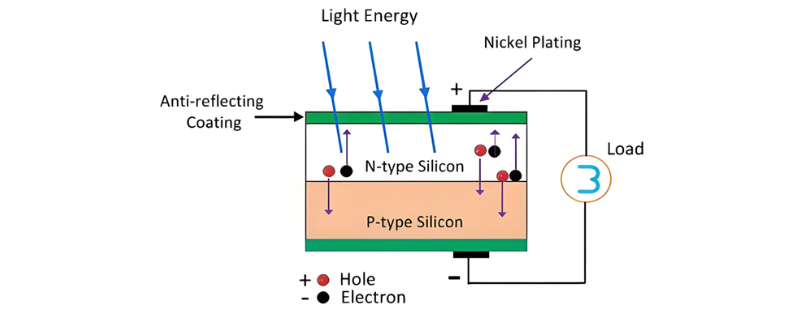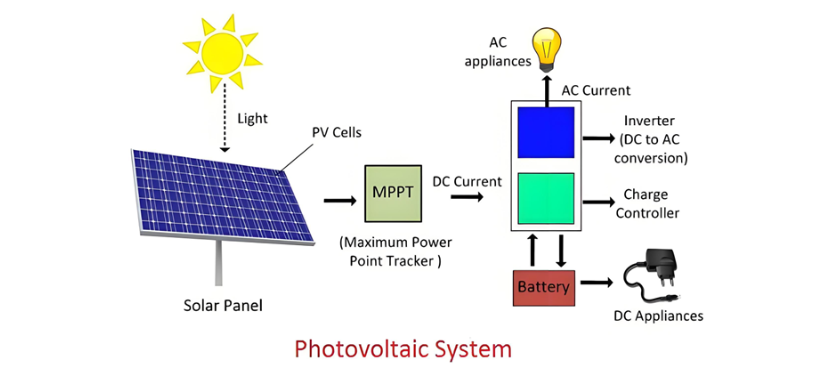Definition
A photovoltaic (PV) cell is a semiconductor device that converts light into electrical energy. The voltage induced by the PV cell depends on the intensity of the incident light. The term "photovoltaic" originates from its capability to generate voltage ("voltaic") through light ("photo").
In semiconductor materials, electrons are bound by covalent bonds. Electromagnetic radiation consists of tiny energy particles called photons. When photons strike the semiconductor material, electrons become energized and start to emit.
These energized electrons are known as photoelectrons, and the phenomenon of electron emission is called the photoelectric effect. The operation of a photovoltaic cell relies on the photoelectric effect.
Construction of Photovoltaic Cell
Semiconductor materials such as arsenide, indium, cadmium, silicon, selenium, and gallium are used to make PV cells. Silicon and selenium are mostly used for constructing the cells.
Take the structure of a silicon photovoltaic cell shown below as an example:
- The upper surface of the cell is made of a thin layer of p-type material so that light can easily enter the material.
- Metal rings are placed around the p-type and n-type materials, which act as their positive and negative output terminals respectively.

Single PV cells are made from either monocrystalline or polycrystalline semiconductor materials.
Monocrystalline cells are sliced from a single crystal ingot, while polycrystalline cells are produced from materials with multiple crystal structures.
The output voltage and current of a single cell are quite low, typically around 0.6V and 0.8A respectively. To enhance efficiency, cells are combined in various configurations. There are three primary methods for connecting PV cells:
Parallel Combination of PV Cells
In a parallel configuration, the voltage across the cells remains unchanged, while the total current doubles (or increases proportionally with the number of cells). The characteristic curve of parallel-connected PV cells is shown below.
Series-Parallel Combination of PV Cells
In a series-parallel configuration, both the voltage and current increase proportionally. Solar panels are typically constructed using this combination of cells to achieve higher power output.

A solar module is created by connecting individual solar cells. The assembly of multiple solar modules is referred to as a solar panel.

Working of PV Cell
When light strikes a semiconductor material, it can either pass through or be reflected. PV cells are made of semiconductors—materials that are neither perfect conductors nor insulators. This property makes them highly efficient at converting light energy into electrical energy.
When the semiconductor absorbs light, its electrons begin to emit. This occurs because light consists of tiny energy packets called photons. When electrons absorb photons, they become energized and start moving within the material. An internal electric field forces these particles to move in one direction, generating a current. Metallic electrodes on the semiconductor allow the current to flow out.
The figure below depicts a silicon PV cell connected to a resistive load. The cell comprises P-type and N-type semiconductor layers joined to form a PN junction.
The junction is the interface between the p-type and n-type materials. When light falls on the junction, electrons start moving from one region to another.
How are Solar Cells Installed in a Solar Power Plant?
Devices such as maximum power point trackers (MPPTs), inverters, charge controllers, and batteries are used to convert solar radiation into electrical voltage.

Maximum Power Point Tracker (MPPT)
An MPPT is a specialized digital controller that tracks the sun's position. Since PV cell efficiency depends on sunlight intensity, which varies throughout the day due to Earth's rotation, MPPTs adjust the panel's orientation to maximize light absorption and power output.
Charge Controller
A charge controller regulates the voltage from the solar panel and prevents battery overcharging or overvoltage, ensuring safe and efficient energy storage.
Inverter
An inverter converts direct current (DC) from the panels into alternating current (AC) for use with standard appliances, which typically require AC power.